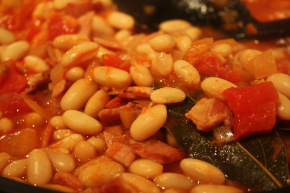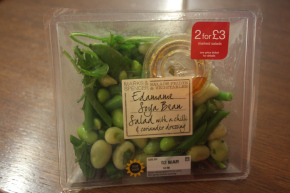My first foray into the world of chutney took place purely by accident.
One evening in August I asked Tom if he could pick up one of those market-sized bowls of tomatoes on his way to the flat. An hour later, he still wasn’t back. I was starting to worry. Then, with a big flourish he threw open the flat door, proudly holding aloft a 5kg box of tomatoes.
Not exactly what I had in mind. Particularly as we were packing to go to Scotland, and I hate food going off. So I decided that the obvious thing to do would be to whip up some chutney—how hard could it be…?
I scoured the internet and worked out that the key ingredients were vinegar and sugar—get that ratio right, and pretty much anything else seemed to go. So I decided to start with some spicy tomato chutney to make a dent in the box of tomatoes, which were taking up far more space in the flat than tomatoes really should.
I painstakingly chopped and peeled and diced all the ingredients, put them in my beautiful, red pan on the hob and started stirring.
After half an hour the tomatoes, onions and apples had started to soften…and my arm was beginning to ache. After an hour and a half the chutney was turning a reassuringly brown colour, but it was still very liquid…and repetitive strain was setting in.
Two hours in, the chutney still had some reducing to do and my (normally 40-minute long) attention span had exceeded its limit—so I popped off to wash my hair and thought the chutney could look after itself…
…as I stepped out of the shower, a bitter, smoky smell stung my nostrils. There is no nice way of putting it—no ‘caramelisation’, no ‘gentle carbonization’ —but the bottom three inches of chutney had solidified and welded itself to the base of my pan in a stinky burned mess.
burned pan after attacking it with several scouring pads
I phoned up my mum (regular culinary ‘go-to’ and chutney specialist) and she had the helpful advice of: “I can’t think how I used to do it before I had an aga”.
One of her more frustrating responses. Particularly for an East End cook who couldn’t be much further away from the rural idyll of agas, orchards, and farm shops, where chutney seems to just happen.
On a more helpful note, mum did send me her Old Doverhouse recipe so, with several kilograms of tomatoes left, plums in season and a rugged determination to overcome my chutney demons, I got my second-favourite pan off the shelf and tried again:
Old Doverhouse Chutney
1 1/2lb Plums
1 1/2lb Coking apples
8 oz Green or red tomatoes
1 lb raisins
8 oz onions
1 1/2 dem sugar
4 oz preserved ginger [the sort that isin syrup]
1/4 oz garlic
1/4 oz fresh chillies
1 1/2 tble sp cook salt
1 pint malt vinegar.
Once again, I was wildly attentive for the first hour, watching the fruit soften. For the second hour I was skipping about with excitement as the flat filled up with distinctly chutney-ish smells.
Then, on entering the third hour of cooking, something particularly good came on tv. I nipped out of the kitchen, and missed the crucial ten minutes where the chutney goes from being a bit liquidy to a bit welded to the bottom of the pan.
The Old Doverhouse chutney wasn’t quite bad enough to chuck (the first batch was). But it certainly wasn’t good enough to be proud of…and with two pans written-off, I angrily shelved all chutney-making plans. Indefinitely.
And so chutney remained off-limits until I went to visit Tom in Brixton last weekend. His friend Charlie, who deals in fruit much in the way that others might deal bootleg alcohol or duty free cigarettes, had dropped by and suspiciously left a deposit of about 40 pears in the corner.
What better opportunity to overcome my demons. So, on Sunday, I dozed for most of the morning, zoning in and out of The Archers omnibus and wondering what I could do differently to make sure that third time really was lucky…
half-listening to the goings-on in Ambridge generally helps me focus the mind
…and then I remembered a red cabbage recipe I’d made before which simply requires cooking apples, onion, cinnamon and red cabbage to be put in a pan in an oven for a few hours until it’s all soft and melded together and wonderful.
Working on the same principal I made the simple decision to not make the chutney on a hob (so it didn’t have an intense heat directly heating the base of the pan), but instead put it in an oven for a few hours so that it could lovingly simmer away, with medium heat wafting all around it rather than burning it from below.
Tom’s flatmate bravely lent me his cast iron pan (truly a brave decision considering the burned-chutney incrusted on all of my favourite pans), and so the third trial began.
I put all the ingredients in the pan, and then made some bolognese.
An hour later I stirred it, and then went to watch The History Boys. Around the time that Hector is groping a schoolboy on a motorbike I stirred it again. Then as the credits rolled I took it out of the oven…triumphant!
I highly recommend this recipe, and I highly recommend the method of putting the chutney in, not on the oven, and meddling with it as little as possible.
Pear Chutney
12 pears (peeled, cored and cut into 2cm cubed pieces)
350ml cyder vinegar
300g dark brown, soft sugar
1 big onion (diced)
1 large handful of rasins
2 big, hot peppers (sliced finely)
1 heaped teaspoon cayenne pepper
4 garlic cloves (crushed)
Mix the cyder vinegar and the soft sugar in a small pan on the hob. Bring to the boil and simmer gently for five minutes.
Pour over the other ingredients in a cast iron pan, and put it in an oven between 180-200C without a lid on so that it’s very gently simmering. Leave for 2.5-3 hours, stirring occasionally.
Use boiling water to thoroughly wash two medium-sized kilner jars (we found some for £1 at Poundland) and put them in a warm oven to dry.
Spoon the chutney into the jars and let it cool before putting on the lid.
Read Full Post »


